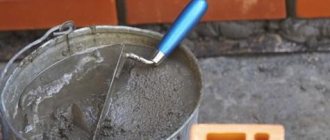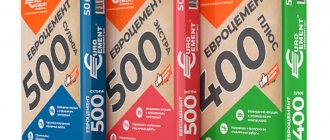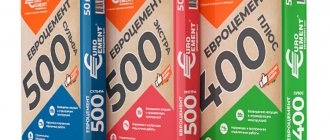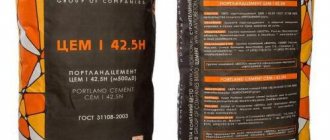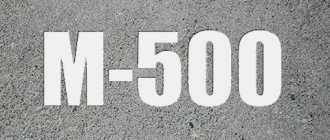- home
- Concrete Production
- Concrete fillers
Reading time: 6 minutes
2082
A certificate for cement is a mandatory document that confirms the implementation of the procedure for checking the technical properties of a substance for compliance with established standards and norms. The high quality of the building material must be checked during various studies, after which the manufacturer has the right to sell the product without any restrictions.
A certificate of conformity for cement is a document that you must have for the production, sale and import of bulk construction materials into the state legally. The document confirms the safety of the product, certifies the fact of compliance with a number of regulations: GOSTs (30515-2013, 31108-2016, R 57293-2016/EN 197-1:2011) and technical regulations of the Customs Union.
Be sure to check the compressive strength at 3/28 days and the compressive strength after steaming at 3/28 days. Certification is carried out in three stages, often carried out in parallel. Due to the fact that cement is used in a large number of repair and construction work, where it is extremely important to provide the necessary characteristics to structures and buildings, the material must exactly comply with all specified characteristics.
The strength, reliability, durability, resistance to various types of loads and impacts of concrete, which is used to implement certain tasks, depend on the properties of cement. The basis of the test is confirmation of the cement of the specified brand and strength class: for example, M500 cement must demonstrate certain characteristics and cannot show the properties established for M300 or M400.
A certificate for cement can only be issued by accredited companies and certification centers that have their own or cooperate with third-party laboratories to conduct research and examination. The laboratory must be equipped with modern instruments and must be accredited by the Federal Accreditation Service.
- 1 Types of cement
- 2 Cement testing
- 3 Conditions for obtaining a certificate
Certification
Mandatory certification
in the TR CU system
Cement is subject to quality confirmation in accordance with TR CU 014/2011 Technical Regulations of the Customs Union “Road Safety”
This technical regulation is adopted in order to ensure at the stages of design, construction, reconstruction, major repairs and operation of highways.
In the GOST R system
Government Decree N 930 “On Amendments to the Unified List of Products Subject to Mandatory Certification” specifies the types of cement that are subject to mandatory confirmation of conformity. This list includes the following items:
- Portland cement
- Aluminous cement
- Slag cement
- Supersulphate cement and similar hydraulic cements, whether or not colored, prepared or in the form of clinkers
List of products requiring mandatory confirmation of conformity:
- aluminous;
- supersulfate;
- slag;
- hydraulic;
- Portland cement;
- cement mixtures (painted and unpainted);
- cement clinkers and ready-mixes.
Cement Eurocement M500 D-20 50 kg (CEM II A-Sh 42.5 N)
Construction of a private house, arrangement of adjacent territories and buildings, apartment renovation and other construction work of a high professional level - all these tasks are easily solved with the help of Eurocement M500 cements, which ensure high quality, strength and durability of concrete products and structures. Cements of the Eurocement brand are developed taking into account the climatic characteristics of our country, the ease of their use, with increased requirements for the quality of the finished product and the duration of its operation.
Main stages of cement certification
- filing an application for certification;
- consideration and decision-making on the application;
- sampling for identification and testing;
- carrying out the necessary checks (analysis of technical documentation, identification, sampling, testing, analysis of production status);
- analysis of the results obtained and making a decision on the possibility of issuing a certificate of conformity;
- issuance of a certificate of conformity;
- inspection control of certified products;
- corrective measures in case of violation of product compliance with established requirements;
- informing about certification results.
Features of concrete hardening using self-expanding cement
The self-expansion effect is achieved through the creation of Ettringite minerals. The formation of Ettringite crystals occurs through the interaction of additives - aluminates and water-based calcium sulfates. At the same time, the mineral crystals contain a large number of H2O molecules.
It is this circumstance that provides the self-expansion effect. The solid components of self-expanding cement, interacting with each other during the process of hydration, add water to themselves and thus increase their volume by several orders of magnitude.
One of the main features that characterize this type of binder is that in solutions based on it, two processes occur in parallel: the process of formation of ettringite, which ensures an increase in volume, and the process of setting and hardening. If the process of mineral formation occurs earlier than the process of setting and gaining low strength, the self-expansion effect will not work. Ettringite crystals will “compress” the pliable mass in the opposite direction.
Therefore, when constructing structures made of self-expanding cement, it is necessary to ensure constant moistening of the surface for from 12 hours to 7 days, depending on the type of binder.
The application for certification contains:
- information about the applicant organization, including the name and location (legal and actual address) of the applicant, bank details;
- name and location of the manufacturer;
- information about the product and its identifying features (name, code according to the current all-Russian product classifier or code of imported products in accordance with the Commodity Nomenclature for Foreign Economic Activity used in the Russian Federation), technical description of the product, information about the instructions for its use and other technical documentation describing products;
- information about regulatory documents in accordance with which products are manufactured;
- information about regulatory documents, compliance with which is confirmed;
- obligations of the applicant to comply with the rules and conditions of certification.
Advantages
Cement "Eurocement M500 D20" is an affordable and popular material with a whole set of obvious advantages:
- forms strong and durable surfaces;
- universal in use;
- resistant to water and aggressive environments;
- easy to install;
- withstands temperature changes over a wide range;
- does not contain hazardous substances;
- can be used in winter;
- safe for contact with fresh water;
- hardens quickly enough at any humidity and temperature.
Documents required for certification:
- a copy of the document confirming the registration of the applicant in the prescribed manner as a legal entity;
- a copy of the agreement on the transfer of powers of the foreign manufacturer in terms of certification and liability for non-compliance of products with established requirements (if the applicant is a person authorized by the manufacturer);
- information about the taxpayer identification number;
- a copy of the statutory documents;
- a copy of the regulatory document according to which the products are manufactured;
- quality passport and information necessary for product identification (data on composition, raw materials, purpose, application features, etc.);
- information about the results of laboratory tests over the past year;
- a copy of the technological regulations for the cement production process, developed in accordance with GOST R 58100;
- copies of documents confirming the legal status of the foreign manufacturer, address of location and address of the place of production, with translation into Russian completed by an authorized organization;
- a copy of the radiological test report issued by a testing laboratory accredited in the national accreditation system;
- protocols of physical and chemical tests conducted by the applicant (if available).
forms
Conditions for obtaining a certificate
The main conditions for obtaining a certificate are the provision of all necessary documentation to the accredited center and the passage of all types of testing by samples. There are many such centers in Moscow, and when applying, you need to check accreditation with the Federal Laboratory Service, as well as the correct form of the certificate (provided that the cement has passed all checks).
What documents are needed to obtain a certificate:
- Application in the prescribed form.
- All statutory documentation.
- Technical documentation with product description, drawings, data sheet, instructions, etc.
- Certificates TIN, OGRN.
- Specifications if the product is not manufactured in accordance with GOST.
- Documents confirming ownership or lease of production space.
- For foreign importers/manufacturers: application, statutory documentation, technical documents, invoice/contract.
The validity period of the received certificate is 1-3 years for a series of cement production/supply. In addition, a certificate can be issued for the period of operation of the building material when assessing the quality of a specific batch of product. After receiving the certificate, you need to apply markings to the products to confirm the presence of a permit and to be able to legally sell the material.
MasterEmaco A 640 and other popular options
- MasterEmaco A 640 (Macflow) is a plasticized expanding cement with a highly fluid consistency, used for the installation of anchors, metal structures and equipment, the production of mortars and concrete used in the construction and repair of airfield and road surfaces.
- CEM I 52.5 R (PTSB 1-500 D0) Adana is a white cement with absolute inertness to pigments and a whiteness of about 90%, characterized by increased weather resistance, used for the preparation of colored solutions.
- SRB 400 is a binder with an aluminum oxide content of about 40%. The main components are calcium aluminates, which make cement an ideal option for the refractory industry.
Types, application
Special cement (cement for a special purpose or type) is a group of binders that differ from cements based on Portland cement clinker in the type of raw materials, production technology, composition, properties, and, accordingly, areas of application that depend on the type and characteristics.
Cement. Photo by LafargeHolcim
As a result, special cement is a unique construction and industrial material that has special characteristics in terms of speed of strength gain, shrinkage, plasticity, sulfate and frost resistance, water resistance and aesthetic parameters. The group of special cements includes several types of binders : non-shrink, white, aluminous, acid-resistant, tensile, expanding, sulfate-resistant and slag-alkaline. Each type has its own scope of application.
Aluminous/with glizhem/clay
Like any special cement, alumina has special properties, the presence of which is determined by the special composition and production technology . Limestones and bauxites are used as raw materials . The clinker composition includes monocalcium aluminate, dicalcium silicate, gehlenite and other components. Aluminous cement (AC) is produced in accordance with technology that involves enriching the main components with alumina . Changing the setting time ensures the introduction of boric acid, borax, calcium chloride into the clinker to slow down setting or lime, Portland cement and gypsum to accelerate.
GC is characterized by a high rate of strength gain . Concrete mortars based on aluminous binder achieve 100% brand strength within 72 hours after mixing with water. Setting and strengthening of concrete based on GC should be carried out at temperatures from 0 to +20 degrees Celsius and high air humidity, because When hydrated, cement releases 2 times more heat. At ambient temperatures above 25 degrees, concrete shows a decrease in strength gain . A further increase in temperature can lead to a significant decrease in strength and destruction of the structure. Significant heat generation allows concrete work to be carried out at air temperatures down to -10 degrees without additional heating.
Cement stone has an increased density compared to a monolith based on Portland cement. GC is characterized by a high cost compared to the price of ordinary Portland cement. The features of the GC ensure its use for the preparation of solutions used in the high-speed construction of objects, the restoration of structures, the construction of containers in contact with organic acids , salt solutions, sulfur and starch, and the rapid repair of holes in ship hulls. Also used to solve the following problems:
- construction of structures that are subject to special requirements for a minimum period of strength development;
- construction of hydraulic and underground structures operated in conditions of increased aggressive sulfate activity of the environment;
- cementing oil and gas wells, although well cement is intended to solve these problems;
- operational installation of foundations for the installation of production equipment: presses, machines, crane beams, etc.;
- production of prefabricated concrete products;
- repair work, including urgent: buildings, bridges, dams, roads, foundations and other structures.
Depending on the concentration of impurities, GC has the following varieties. The usual composition, the concentration of alumina in which does not exceed 66%, and the proportion of silicic acid is approximately 3%. High-alumina (HAC) contains about 76% alumina and a concentration of silicic acid reduced to 1%.
GC-40 and other brands
Aluminous cement has different compressive strength : 400, 500 and 600 kgf/sq.cm., unequal changes in strength parameters within 72 hours after pouring, hence the classification into separate grades, in accordance with GOST into the following: GC-40, GC -50 and GC-60. GC-40 compositions increases over 3 days from 22.5 to 40 MPa, and is used in construction. GC-50 is characterized by an increase in strength from 27.4 to 50 MPa, and is in demand in the fuel and energy industry. GC-60 is characterized by increased strength, the indicators of which vary from 32.4 to 60 MPa, and is used for special purposes in metallurgy and the defense complex.
SRB-40, Secar-71 and so on
- Aluminous refractory cement SRB-40 is a high-quality binder from a French manufacturer, the main components of which are calcium aluminates, used for the production of quick-hardening architectural concrete, dry construction and repair mixtures, and is also a material for creating waterproofing (hardening in wet conditions increases the grade to M1000) , special concretes for heat-resistant products and fire-resistant masonry mixtures. Products based on binders can withstand temperatures up to 1300 degrees.
- Secar-71 is a high-alumina cement, the aluminum oxide content of which is about 70%. It is used to create concrete and reinforced concrete structures, the design strength of concrete in which must be achieved within 1-7 days, during the construction of underground and offshore structures that are exposed to the sulfate environment, cementing cold oil wells, sealing holes in ships, operational construction of foundations for cars, restoration of rear and axles, production of dry construction and fire-resistant mixtures.
- CIMSA ISIDAC-40 is a fast-hardening binder used in the construction of runways, bridges, dam spillways, highways, sewer and wastewater systems, engineering pipeline systems, structures that must be launched as soon as possible.
Fireproof/heat resistant
In some sources you can find information that GC is a fireproof material; concrete based on it can withstand temperatures up to 1750 degrees. But this fact is not entirely true. The characteristics of GC in terms of heat resistance are higher than those of Portland cement. But the indicated temperature limits are valid only for high-alumina cements of VGC grades I, II and III. The astringent of these brands retains its own properties even at temperatures up to 1800 degrees . Structures based on ordinary Portland cement begin to collapse at temperatures above 250 degrees; destruction becomes irreversible at temperatures above 500 degrees.
High-alumina cement (HAC) is a high-strength, fast-hardening binder based on calcium mono- and dialuminates, obtained by finely grinding the main components of the charge, subsequent firing in a rotary kiln and deep grinding of clinker in a jet mill. The main properties of VHC are high strength and rapid early hardening, resistance to aggressive environments and fire resistance. These characteristics ensure active use.
For ovens and more
Refractory cement is used for the preparation of masonry mortars for the construction of stoves and fireplaces, mortars for coating furnaces of stoves and fireplaces, mortars for the construction and operation of industrial furnaces of various types: tunnel, muffle, laboratory, etc. VGC is also used in the industrial production of dry refractory mixtures , refractories , mortars, general purpose concrete monoliths. Thus, refractory cement is used in the construction of structures whose operation is carried out at significant ambient temperatures. In addition, VHC is used in the production of quick-hardening solutions for various purposes.
SRB 710, 80 and other popular options
SRB 710 is a calcium aluminate binder containing approximately 70% aluminum oxide, intended for use at temperatures above 1400 degrees. Does not contain additives, but goes well with them. Recommended for the production of refractory materials, in particular, self-flowing refractory concrete.
There are two options for Internet users’ request for “SRB 80”. SECAR 80 is a high-alumina (aluminate) cement developed for the preparation of refractory concrete, the aluminum oxide content is about 80%. The stable composition ensures a high level of concrete properties. SRB 820 is an aluminous cement, a specially formulated binder with integrated additives, suitable for use in a wide range of refractory concretes.
Types and characteristics of self-expanding materials, what they are, advantages and disadvantages
Expanding (or self-expanding) cement is a group of binders with special properties. In accordance with their name, these are cements that increase in volume as they set and harden, in contrast to ordinary types, which shrink during hardening. This property allows the cement to have no pores, so its strength and moisture resistance remain at a high level. The expansion of the cement mixture ensures that all voids, seams and cracks in the building structure are filled. The basis of expanding materials is cement made from aluminous slag or cement mixtures with an alumina component ; gypsum is added to the composition to accelerate hardening. Achieving an expanding effect is facilitated by the inclusion of special components: aluminum compounds and magnesium reagents. The materials have a number of advantages:
- high adhesion and gradual expansion are due to a tight fit to the base and uniform filling of cracks and other defects;
- frost resistance reaches 1500 freezing and thawing cycles, which is due to minimal moisture permeability;
- resistance to temperature changes;
- the ability to perform concrete work at low ambient temperatures;
- resistance to atmospheric and chemical factors;
- Possibility of use as a base or finishing composition.
Self-expanding cements are not without some disadvantages:
- high cost compared to the price of general construction cements;
- short shelf life , in sealed packaging the products are stored for 1-3 months;
- limited production volume , it is not always possible to find products on sale, and to purchase a large batch you will have to place a personal order;
- difficulty of use, the solution hardens quickly, work requires experience and dexterity;
- high probability of purchasing low-quality products;
- the need to care for the concrete solution after pouring, the monolith must be regularly moistened with water and covered with plastic film for 5-7 days.
Gypsum-alumina
Gypsum alumina expanding cement (GAEC) is produced by co-grinding or mixing high-alumina clinker and gypsum, the presence of which ensures rapid setting and hardening. Setting of the solution begins after 20 minutes and ends no later than 240 minutes. Final hardening and set of brand strength occurs after 70-85 hours. In accordance with GOST, GGRC has the following characteristics:
- compressive strength after 72 hours after mixing is 275 kgf/sq.cm;
- setting begins 15 minutes after mixing and ends no later than 4 hours;
- the change in volume when gaining strength in water for 28 days is uniform;
- linear expansion 72 hours after mixing is in the range of 0.1-0.7%.
GGRC is used for the preparation of non-shrinking waterproof expanding mortars, concretes, waterproofing coatings, which are used:
- in metro construction , for sealing seams between concrete structures, repairing and strengthening old structures, waterproofing;
- during the construction of civil and industrial structures , for waterproofing foundations, sealing seams and sockets of water supply and sewer collectors operating under conditions of excess pressure reaching 10 kgf/sq.cm, during the construction of concrete tanks;
- in the municipal economy , for waterproofing treatment facilities, eliminating emergency situations, when carrying out repair work on structures operating in high humidity conditions.
The production of GGRC in Russia is carried out by the Pashiysky Metallurgical and Cement Plant.
Straining/intense: NTs-20 and more
Tensile cement (TS) or tensile cement, some users call this type tensile cement. NC is produced by mixing crushed components in appropriate proportions . The binder contains Portland cement, aluminous and blast furnace slag, and gypsum . The first component is the base, the second acts as an expanding additive, the last two play the role of auxiliary additives.
Ordinary Portland cement is used as a prestressing cement. Vimos Photos
A feature of the species is the ability to first harden and gain strength , and then increase in volume . Setting of NC-based solutions begins 30 minutes after mixing and ends after 4 hours. The strength of the monolith 28 days after mixing is 500 kgf/sq.cm. Concrete based on NC is used for the construction of all types of underground structures, swimming pool bowls, wastewater treatment plant tanks , for the construction of monolithic and prefabricated structures with increased durability, water resistance and frost resistance, for the creation of concrete structures that can withstand significant mechanical loads: runways, bridge crossings, etc. P. NC can be divided into 4 types depending on the type of self-stress:
- NTs-5, the self-stress of which does not exceed 0.7 MPa;
- NTs-10, 0.7-2 MPa;
- NTs-20, 2-3 MPa;
- NTs-30, more than 3 MPa.
The first two types are rarely used. The most common in construction is NTs-20, it has excellent non-shrinking properties, the material is easy to work with, and no additional waterproofing is required. The type NTs-40 is often distinguished, characterized by almost 100% waterproofing, therefore, when constructing swimming pools, collectors, and underground structures.
On sale it is possible to find NC produced by the Pashiysky Metallurgical and Cement Plant and PJSC Podolsk Cement.
Waterproof/moisture-proof/hydrophobic/waterproofing
Concrete based on ordinary cement is not able to withstand high humidity. Constant exposure to moisture leads to the destruction of cement and weakening of the reliability of the entire concrete structure. Therefore, you can either spend effort and money on waterproofing structural elements during the construction process, or initially use cement with the necessary characteristics. The second method of strengthening the structure is more economical. Moisture-resistant cement is produced in two varieties:
- Waterproof . It has less porosity, so water does not penetrate inside and does not allow moisture to pass into the upper layers of the structure. Successfully resists wet air and snow. Copes with water pressure. Does not allow moisture to pass under high pressure.
- Water resistant . It repels water, does not let it in, but is not able to withstand the pressure of water.
Ceresit CX 5/2 mounting and water-stopping cement 2 kg. Photo OBI
To solve construction and repair problems in domestic conditions, no distinction is made between these two varieties. But when implementing important projects, minor differences in characteristics must be taken into account.
What is it, description
Waterproof Expanding Cement (WEC) is a special purpose hydraulic binder. It has several alternative names; in open sources you can find the following names: waterproof, moisture-resistant, hydrophobic, waterproofing. VRC is produced by grinding or mixing in a screen alumina cement (70%), gypsum (20%) and calcium aluminate .
The setting of solutions based on VRC begins no earlier than the 4th minute, and ends no later than the 10th. In some cases, an increase in the setting period is required, which is achieved by introducing special additives into the composition: borax, citric or acetic acid. VRC is used in the construction of underground tanks, repair of destroyed concrete and reinforced concrete structures, formation of waterproof joints, for waterproofing underground structures, pouring concrete floors in cellars, basements, garages, and constructing decorative ponds.
Non-shrinkage (VBC) and other types
Waterproof cement is divided into two types: WRC - waterproof expanding , discussed above, and VBC - waterproof non-shrinking . The raw materials for the production of compositions of the second type are limestone and bauxite. The basis is aluminous cement. VBC is made by grinding cement with gypsum and lime ash . The main requirement for the amount of cement is 85%, the proportions of the other two components may vary. Sometimes manufacturers use asbestos in an amount of 5% . An important quality is the presence of anti-corrosion properties .
VBC is successfully used in many areas : the installation of insulating shells in reinforced concrete structures that filter water, as waterproofing of underground and underwater tunnels, for sealing seams and joints between building panels. It is important to remember that the use of VBC is advisable in conditions with humidity greater than 75%. Application in dry conditions leads to significant shrinkage of the VBC.
Ceresit
Ceresit CX 5 - quick-setting, waterproof, non-shrinking, frost-resistant cement for quick anchoring of embedded elements in concrete, cement-sand mortars, brickwork, etc.; stopping water flows in cement and concrete enclosing structures; for filling potholes and cracks during repair work. It quickly gains strength, does not cause corrosion of reinforcement, is suitable for interior and exterior work, has excellent adhesion to concrete and metal, and is environmentally friendly.
Ceresit also offers a fast-hardening high-strength mounting cement mixture CX 15 , designed for filling defects between concrete elements, fastening anchors and bolts when installing heavy equipment, fastening embedded metal embedded elements in concrete and reinforced concrete structures.
Expanding Portland cement and Portland slag cement
Expanding Portland cement (EPC) is produced by grinding Portland cement clinker, gypsum, alumina and blast furnace slag . The latter component provides increased strength . Due to its presence, compositions of this type often have expanding slag Portland cement. Setting of the solution occurs no earlier than 30 minutes, completion - no later than 4 hours. Hardening occurs within 30-80 hours. Used for sealing pipe and cable passages and holes in concrete structures, installing anchor connections, sealing joints and seams. Immersion in water or watering the solution after pouring does not provide expansion. The volume change occurs only with a single short steaming.
Plasticized
It is a type of expanding non-shrink cement, the basis is ordinary Portland cement , into which plasticizing components are introduced, it has strength and ductility. The use of cement makes it possible to obtain concrete with high early and final strength , as well as non-shrinking injection mortars . Used in the construction and repair of roads, bridges and runways; for installing anchors, equipment, metal structures and sealing joints and cracks in concrete structures. Plasticized cements are represented by the Macflow trademark .
Sulfate resistant
Sulfate-resistant Portland cement is a type of general construction cement that is characterized by increased resistance to groundwater, sea tides, water level fluctuations, aggressive substances, winter heaving and soil deformations, and other atmospheric factors. , a certain amount of tricalcium aluminate and silicate is introduced during the clinker grinding process .
Portland cement is sulfate resistant. Baucentr Photos
The main properties are low heat generation, increased density, rapid setting and strength gain, resistance to sulfate corrosion and other dangerous and harmful factors. Used in the construction and repair of hydraulic structures , construction of foundations and basements operating in conditions of high soil moisture.
Others
In addition, special cements include other varieties:
Slag-alkali consists of a fine powder, which is a product of grinding 1) waste from the metallurgical industry and caustic alkali or 2) silicate salts or non-silicate salts of weak acids. The advantages of this type are zero cracking, which is due to the low hydration temperature, high strength, heat and frost resistance, and fairly low cost due to the use of production waste. Solutions based on compositions of this type are used in the construction of roads and highways, massive concrete military structures with increased resistance to harmful factors: exposure to water, wind and low temperatures, chemically active substances.
White cement. Photo by LafargeHolcim
Acid-resistant is made from purified quartz sand and sodium silicofluoride through their joint or separate grinding. Liquid glass is used as a sealer . Setting of the solution begins after at least 30 minutes and no later than 6 hours after mixing. Solutions based on acid-resistant cement are resistant to all acids, except hydrofluoric and orthophosphoric, with a strength of 200 to 600 kgf/sq.cm. As important disadvantages, it is possible to consider low resistance to the effects of water vapor, water, alkalis, which triggers the chemical process of converting concrete into an amorphous mass. It is used in the construction of containers for storing chemically active substances, lining equipment at chemical industry enterprises.
White . A special feature of the binder is the snow-whiteness of the solution, and, accordingly, of products and structures made from it. This property ensures the active use of white cement in the production of facing materials, art objects, sculptures and individual decorative elements.
